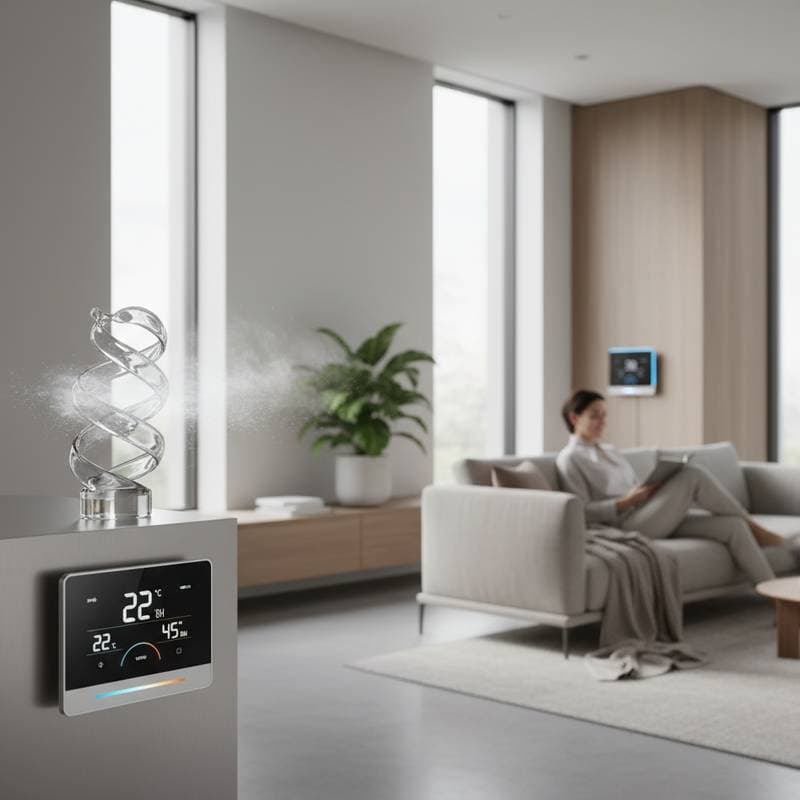Humidity Control Systems: 2025's Hidden HVAC Upgrade
As an HVAC pro, I have seen countless homeowners struggle with that sticky, heavy air that clings to your skin in summer or the parched dryness that cracks wood floors and lips alike in winter. You might have invested in a high-efficiency furnace or a powerful air conditioner, yet your home still feels uncomfortable. The missing piece is often humidity control, a quiet but powerful element that determines how cozy and healthy your indoor environment truly feels.
The Overlooked Problem Behind Comfort
Most homeowners think temperature is the only factor that defines comfort. In reality, humidity is the secret player influencing both how warm or cool a space feels and how much energy your HVAC system uses. When moisture levels swing too high, your air feels warmer, your cooling system runs longer, and your energy bills rise. When humidity drops too low, static shocks, dry skin, and respiratory irritation quickly follow.
In many regions with muggy summers or dry winters, indoor humidity fluctuates wildly throughout the year. Studies show that maintaining indoor relative humidity between 40 and 50 percent can reduce airborne viruses, protect wood furnishings, and lower energy consumption by as much as 10 percent. So if your home comfort feels inconsistent, a humidity control system could be the upgrade you never knew you needed.
Why Humidity Control Matters Now
In modern, tightly sealed homes, air exchange with the outdoors is minimal. This helps with energy efficiency but traps excess moisture or dryness inside. Standard HVAC systems are not designed to regulate humidity effectively on their own. That is where dedicated humidity control systems come in.
Whole-home humidifiers and dehumidification systems integrate directly into your existing HVAC equipment. They balance indoor moisture automatically, creating that crisp, invigorating airflow that feels just right year-round. From my years in the field, I can confidently say that properly balanced humidity can make a modest HVAC system perform like a premium one.
The Hidden Benefits of Whole-Home Systems
You might ask yourself, why invest in a whole-home system when portable units are available? The difference lies in consistency and coverage. A single-room humidifier or dehumidifier can only handle a fraction of your living space. Whole-home systems, by contrast, treat every room evenly, ensuring your entire environment stays balanced without constant refilling or monitoring.
Key benefits include:
- Improved comfort: Air feels cooler in summer and warmer in winter at the same temperature setting.
- Healthier air quality: Regulated humidity helps prevent mold, dust mites, and airborne irritation.
- Protected interiors: Furniture, flooring, and even musical instruments maintain their integrity longer.
- Energy efficiency: Your HVAC system runs less frequently since balanced air holds temperature more effectively.
Expert Strategies for Effective Humidity Control
As an HVAC expert, I recommend approaching humidity balance with the same attention you give to heating and cooling performance. Here are the essential steps to create the ideal indoor environment:
- Assess your current humidity levels. Use a digital hygrometer to measure indoor relative humidity. Readings outside the 40 to 50 percent range indicate a need for adjustment.
- Choose the right system for your climate.
- If you live in a humid coastal or southern region, a dehumidification system will help remove excess moisture that strains your air conditioner.
- In colder or arid regions, a whole-home humidifier restores moisture lost during heating cycles.
- Integrate with your HVAC system. These systems tie into your ductwork and operate automatically, monitored by your thermostat or a dedicated control panel.
- Schedule professional installation. A licensed technician ensures proper sizing, drainage, and electrical connections for reliable performance.
- Maintain annually. Clean filters, check drain lines, and inspect sensors to prevent buildup or bacterial growth.
Practical Considerations Before You Upgrade
Humidity control systems vary in price and complexity. Whole-home humidifiers typically range from $500 to $1,500 installed, while whole-home dehumidifiers can range from $1,200 to $3,000 depending on capacity and integration. The return on investment often appears through reduced energy use and fewer comfort complaints.
It is also important to follow local building codes when installing any system that modifies indoor air quality. Many areas require a licensed HVAC contractor to handle installation and drainage connections to prevent water damage or mold issues.
From a safety perspective, never attempt to handle refrigerant lines or electrical components yourself. While filter cleaning can be a DIY task, installation and internal servicing should always be left to professionals.
Expert Tips to Maximize Efficiency
- Use smart controls. Modern thermostats can monitor both temperature and humidity, automatically adjusting system output.
- Seal air leaks. Gaps around windows or doors can let in humid or dry outdoor air, undermining system performance.
- Balance ventilation. Combine humidity control with proper ventilation to maintain fresh, comfortable air.
- Monitor room-by-room comfort. If certain spaces still feel off, your ductwork may need balancing or sealing.
HVAC technician Laura Chen said, “Most homeowners underestimate how much humidity affects both their comfort and their bills. Once humidity is balanced, the whole system runs smoother and quieter.” Her observation matches what I have witnessed in hundreds of homes where humidity control transformed comfort levels overnight.
Making It Happen
Humidity control is not just an optional add-on, it is a hidden upgrade that can redefine your home’s comfort and efficiency. Whether you are tired of sticky summers or bone-dry winters, the right system can create a sanctuary shielded from the elements.
Reach out to a vetted HVAC expert via AmericanAirHVAC.net for a no-obligation humidity assessment. Our network connects you with trusted professionals who understand local climate challenges and can recommend the perfect system for your home. With expert guidance, you can elevate your indoor comfort, preserve your property, and breathe easier every day.



